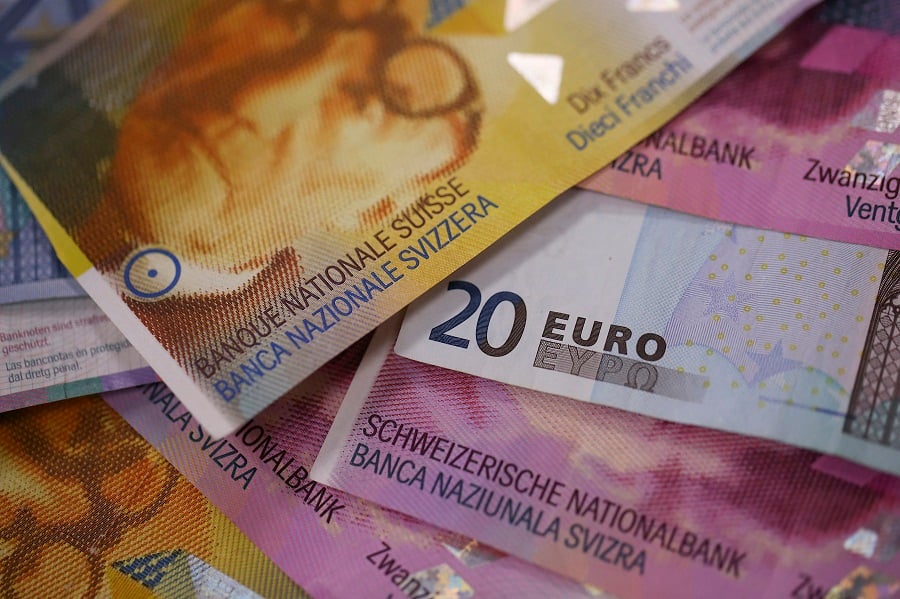Financial advisers who have been watching from a distance the
fallout from Switzerland's surprise move last week to remove its currency ceiling against the euro might want to take a closer look at some of the mutual funds in their clients' portfolios.
While it might be disheartening to see something like the
8.7% one-day drop of the John Hancock Absolute Return Currency Fund (JCUIX), investors in that fund at least knew they were exposed to the currency markets.
The same likely cannot be said for investors in some multi-alternative mutual fund strategies that were also caught flat footed, and were apparently betting big that the Swiss franc was heading lower.
When the Swiss government's actions last week caused the franc, which had already been considered overvalued relative to global currencies, to spike 30% in one day, some multi-alternative mutual funds that are supposed to include layers of diversification suffered out-sized hits.
On the day of the announcement, Jan. 15, the S&P 500 stock index fell by less than 1% while six multi-alternative-strategy mutual funds fell by more than 2%, including an 8.3% drop in the $49 million AMG FQ Alternative Investor (MGAAX).
The $9.7 million AIP Dynamic Alpha Capture Fund (DAFAX) fell by 4.9%, and the $5.3 million Pacific Funds Diversified Alternatives (PLALX) fell by 3.2%.
While those strategies might have been wading too deep into the currencies space, they are all single-manager funds, which don't promise extra layers of diversification.
The same cannot be said for the $138.5 million Collins Alternative Solutions Fund (CLLIX), which suffered a one-day drop of 2.7%, or the $936 million Russell Multi-Strategy Alternative Fund (RMSAX), which fell by 1.6%.
These are examples of funds that allocate to underlying separate account managers, which should provide investors with enough diversification to help them avoid such sizable one-day moves.
Representatives from AMG, Pacific Funds, Collins and Russell did not respond to requests for comment.
Morgan Stanley, which manages the AIP fund as its
first alternative strategy mutual fund, declined to comment.
“Clearly, some of these managers [in the alternative funds category] are doing a lot of stuff and they can catch an investor off guard,” said Jason Kephart, an alternative fund analyst at Morningstar Inc.
“Currency pair trades are a common strategy in a lot of the multi-alternative mutual funds, and that move by Switzerland totally caught people off guard,” he added. “But those kinds of losses in one day makes you question their risk management.”
To be fair, the bet against the Swiss franc rising was widely viewed as a smart — even conservative — strategy.
In 2011, Switzerland pegged its currency to the euro, which effectively set a ceiling on how high it could go. Thus, even as it gained popularity as a safe-haven currency in Europe, heavy bets against it were viewed as almost logical.
And in the case of the John Hancock currency fund, the strategy's quantitative model forced the portfolio into a 42.8% short exposure to the Swiss franc.
It is also worth noting that, as of November, the $1.7 billion John Hancock currency fund was the second largest position in the $1.2 billion John Hancock Alternative Asset Allocation Fund (JAAAX), a multi-alternative fund of funds that dropped 1.3% on Jan. 15.
In addition to being a vivid reminder of the kind of risk some funds in the alternatives category are taking, this kind of volatility among what are promoted as diversified mutual funds should also give investors and advisers a heads up to the
varied iterations of multi-alternative mutual funds.
Just because Morningstar puts them all in the same category doesn't mean advisers should overlook the distinct differences between single-manager funds, funds that use futures and ETFs to replicate various alternative benchmarks, funds that allocate to underlying separate accounts and funds of alternative mutual funds.
It's not quite the wild, wild west. But it's not suburbia, either.







